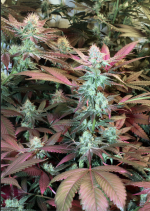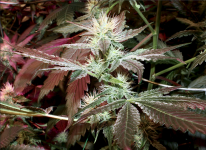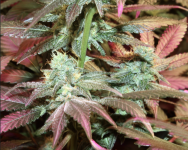Peruse any seed bank catalogue and it won’t take too long before your eyes begin to glaze over in the sea of possibility. So many different strains that one can easily become overwhelmed with options. Take for instance this cart:
This seems like a diverse group of strains that could have endless phenotypic possibilities requiring much effort to parse through growing. But, let’s look at the list a different way:
Sensi Super Skunk (Skunk#1 x Afghan)
Nirvana Big Bud (Afghan x Skunk#1)
HSO Green Crack (Skunk#1 x Afghan)
Aficionado Critical Mass (Afghan x Skunk#1)
Mr. Nice Nordle (Afghan x Skunk#1)
Nirvana Big Bud (Afghan x Skunk#1)
HSO Green Crack (Skunk#1 x Afghan)
Aficionado Critical Mass (Afghan x Skunk#1)
Mr. Nice Nordle (Afghan x Skunk#1)
See it? They’re all Afghan Skunk. Now, I’m not saying that they are all the same seed stock, same P1 selection, or will all give you the same results. The point is to take a large bit of seemingly unrelated information and reducing it to its essence. If you’ve grown out a few Afghan Skunks, you’ll have a rough idea of what to expect: Medium frame, Sweet-to-funky smell, solid yield, short-medium flower time, etc. . What was once a sea of possibility has now been reduced to variations on a theme. There is nuance to this that I’ll get into later but I want to just build the concept first.
The need to reduce strains to their base genetics seems to be more necessary as time goes on because names are becoming more abstract and constantly augmenting an already massive list. Strains mostly enjoy a naming scheme that clearly express the parental genetics involved. G13 Haze, Blueberry Skunk, and Purple OG leave you with little ambiguity as to what was involved or what to expect.
Even the names that break from this convention into non-genetic based monikers such as Girl Scout Cookies, Early Pearl, and Humboldt Snow hint at some observable characteristic to expect. A grower can at least look forward to cookies smell/taste, quick flowering, or a frosty plant based on these names. The more abstract names that have little to no relation to an observable trait of cannabis can leave one confused. My purpose is not to dismiss or say these are 'incorrect', the point is how to find the signal in the noise of the names when simply read as is. For example: Cougar Milk, Pillow book, and Garfunkle do not give much of a hint as to the involved parental genetics or any observable trait. Looking into Garfunkle, you see it is (Dumpster x 88G13HP) and can now expect Afghan type traits. If you were looking for a nice sedating influence, this strain now is applicable to your project where before it was an abstract unknown.
Here are two strains that by their name give little clue as to what is happening genetically (again, not a knock) but similarities become apparent when reduced to their genetic base.
Madness (Hazeman) - (Bubba Kush x 88G13HP)?Afghan
Deep Line Alchemy #9 (Bodhi) - (Kush 4 x 88G13HP)? Afghan
I find analyzing strains with this genetic reductionism to help conceptualize what I’m getting into when growing out different strains or planning a project. I like to think of genetics from the perspective of a handful of base lines that provide the ingredients to all of the work available. I think of the base lines as Afghan, Haze, Skunk, OG, & Chem. To me, these each evoke a clear morphology all their own and each serves as a great collective of expectations when encountering them. To reiterate, this is my personal list that is effected by that which I mostly deal with; your list may differ and that’s great. The point is to devise a method of analyzing seemingly different and chaotic genetics that is useful for you.
For example, I can understand if someone included Cookies to the list of base genes as it quickly conjures a morphology and trait spectrum of its own. Although one could further reduce cookies to an OG variant, the fact that it is as ubiquitous in modern work validates this category as a method of quick reference when conceptualizing what such strains brings to the table. Similar criticism could be leveled at my use of Chem as a base strain as it could be further reduced to Afghan variants but as my personal endeavors heavily use this offshoot, it is applicable. It is more helpful for me to think of Chem as a base ingredient as so much work is based on this specific line. Again, the point to all this is to give yourself a shorthand way of quickly analyzing many different strains in a manner that is easily conceptualized and greatly helps in the planning of project pairings later on.
Now, you maybe thinking, “But that’s so generic! Afghan doesn’t include Pakis or Indian lines. Where is the room for nuance?” First off, for every Paki or Indian line, there are 20 Afghani lines. This process has to be practical for you. Nuance comes with deeper analysis after the superficial parsing of information. Once you’ve decided you want to find a solid Kush, you can further broaden your analysis to include the nuanced similar strains that can give you specifics you’re looking for.
Suppose I offer to take you to breakfast at a new restaurant. I’ve already been to this place before and keep raving about their biscuits and gravy (BnG). You like BnG so decide it’s what you’ll order. At this point, you only have a rough estimation of what will ultimately be presented to you when served; some type of savory baked good with some kind of fat-based sauce. Although you’re sold on the BnG, you decide to look at the menu description of the dish.
“2 flaky buttermilk biscuits served with a sausage country gravy”
Now you have a better idea of what you’re in for. It will not be until to take a bite that you get the nuance of how it was seasoned, the spiciness of the sausage used, the flakiness of the biscuits, etc.
Now, next week I tell you I’m taking you to a different restaurant to try the Goobagoo. You’re at a loss?♂️. You’ve never heard this word before and have no earthly idea what the hell that is. You get the restaurant and open the menu to read
“2 crumbly cream biscuits served with thickened chorizo au jus”
It hits you, Goobagoo is just a variation on biscuits and gravy. The biscuits are a little different texture, the sausage is a bit spicier, and the gravy is darker and a bit thinner, but it’s just BnG. The differences between the two dishes is within a range of possibility. You aren’t ordering BnG and getting served a pasta dish.
This same concept was at play at the beginning when I named
They, like the Goobagoo, seemed like a spectrum of wide possibility, but upon reading the menu, you realize they’re all Afghan Skunk. Sure, there will be variations in the “spiciness, texture, portion, and flavor balance” (potency, density, yield, and smell/taste) but the point is to give a quick analysis for what you’re about to “eat”.
I’ve found this practice to help make sense of seemingly unrelated genetics and help with planning out project pairings. After awhile it became a default method to analyze seed drops and seed bank menus. It's a mental lineage chart breakdown that gets to the essence of it. Just as assessing phenotypes, you aren’t necessarily systematically going through an exhaustive checklist of traits to make conclusions, you kind of implicitly make the assessment. I’ll expand on this concept in a later post, “Planned Purposeful Pairings”.






